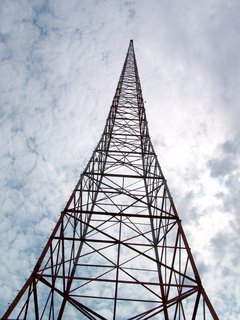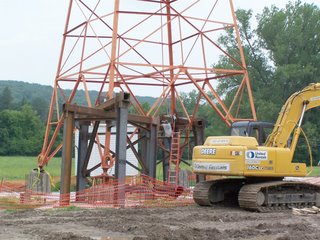Foundational issues
Thursday and Friday were lost days for blogging purposes... a combination of intricate printed circuit repair and unrelenting paperwork made the idea of staring at a computer screen about as inviting as a bowl of ice cream at room temperature.
That, and we've been in Breaking News! mode all week. Nowadays it's the weather: ohmygosh, it's raining, break into the programming to let everyone know. Send the satellite truck to Fair Haven to show a washed out culvert. Roll every truck! We don't know where or why, but get out there! Intense concentration punctuated by annoying interruption.
This morning feels a lot more productive: the front brakes on my Saturn Ion have been making odd noises, so off to Advance Auto Parts for a new set of pads. I've seen a lot of Advance in the three years since we bought the Ion, mostly for replacement front turn signal bulbs that would last only a few weeks at a time. Finally Saturn issued a recall concerning the problem and added a couple of resistors so that the bulbs wouldn't burn so bright when operating as daytime running lamps.
It's been a disappointing experience: our first Saturn, a 93 SW2, ran for ten years and 200,000 miles with little more than routine maintenance; it's easily our favorite car. The second Saturn, a 2000 LS2, had some problems from the start but was generally okay -- but we replaced it after five years when it became obvious that it would need major work to pass the state inspection. The Ion is just not well built or reliable: not in major areas, but in details that become annoying. Short-lived bulbs. Underengineered seat release knobs that snap off. A failed fan switch. Parts that don't line up correctly -- like the right rear door. It won't leave me stranded by the side of the road, but I might wind up in a muggy rainstorm with a defroster that only comes on at quarter power.
I wouldn't be surprised to see the Ion get replaced with another Hyundai, as we replaced Laurie's LS2 with a Santa Fe. This really overcooks my grits, as they say; Saturn has wonderful dealers who are great to work with, but the cars just aren't what they were (or ought to be). The Hyundai dealers aren't in the same league, but their cars are well built and give a lot of value for the money... and the ten year warranty is more than triple the Ion's. I figure that I know competent mechanics, so I can work around a poor service department if the car is worth the effort.
The brake job went quickly and easily, and I was pleased to find that the timing was just right: the pads were down to about 1/8th of an inch but hadn't gone down to the rivets, so the rotors don't need to be changed. Hurray! All told, I figure we saved about $200 by doing it myself.
Celebrated by taking the car for a brief spin to seat the pads, fill up the tank, and check the tire pressure (the Nedrow Hess station is one of the few remaining places with free air). Got about halfway there and a huge doe came blasting out of the woods in front of me. Oh, yes -- those new brake pads definitely worked. Felt like one of those commercials for a national muffler chain: "you never know when you'll have to stop fast... until..." All I lacked was a baby in the back seat to complete the picture.
Drove around the corner, which takes me past the south side of WSYR's AM tower field.
 One of the first sights to greet you when you drive north into Syracuse: sweep around the curve on I81 near the Nedrow exit, and there's the triple tower array in the valley, flashing their beacons as they have been doing for more than 60 years. Before the interstates cut through the city... before the MONY building with the star on top... before the Carrier Dome. The two north towers are older, built before the Army Corps of Engineers rechanneled the winding Onondaga Creek that meandered past the field. The south tower is newer, but still older than I am. Years have passed since cows grazed in the field, and now the only activity you will find is an occasional youth buzzing through on an ATV. The field, which used to be even and grassy, is now weed covered, rutted and heaved where fill from the creek has settled. The concrete bases on which the towers stand have settled and deteriorated, reportedly giving the south tower a slight lean.
One of the first sights to greet you when you drive north into Syracuse: sweep around the curve on I81 near the Nedrow exit, and there's the triple tower array in the valley, flashing their beacons as they have been doing for more than 60 years. Before the interstates cut through the city... before the MONY building with the star on top... before the Carrier Dome. The two north towers are older, built before the Army Corps of Engineers rechanneled the winding Onondaga Creek that meandered past the field. The south tower is newer, but still older than I am. Years have passed since cows grazed in the field, and now the only activity you will find is an occasional youth buzzing through on an ATV. The field, which used to be even and grassy, is now weed covered, rutted and heaved where fill from the creek has settled. The concrete bases on which the towers stand have settled and deteriorated, reportedly giving the south tower a slight lean.
How does one go about replacing footings for a tower 330 feet tall, weighing hundreds of tons? As it turns out, like this:
 You build a temporary brace around the failed foundation while you build the replacement.
You build a temporary brace around the failed foundation while you build the replacement.
 These two fellows are from Montana, doing here what they do around the country for other aging stations. And from the looks of things, they're very good at it. Today they are placing temporary jacks on the northwest and southeast legs; once they are secure, the ceramic base insulators are removed and the old footings are demolished. Forms are built for new footings, and new concrete is poured. The team leader says that they expect to have two legs of two towers ready for pouring on Monday, and once they cure, they move the jacks to the opposite legs and repeat the process.
These two fellows are from Montana, doing here what they do around the country for other aging stations. And from the looks of things, they're very good at it. Today they are placing temporary jacks on the northwest and southeast legs; once they are secure, the ceramic base insulators are removed and the old footings are demolished. Forms are built for new footings, and new concrete is poured. The team leader says that they expect to have two legs of two towers ready for pouring on Monday, and once they cure, they move the jacks to the opposite legs and repeat the process.
 I remarked at what an amazing sight it is; the leader just shrugged. "It's what we do."
I remarked at what an amazing sight it is; the leader just shrugged. "It's what we do."

<< Home